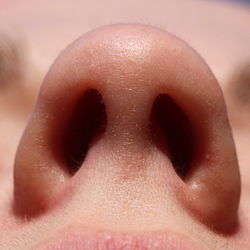Nostril
| Nostril | |
|---|---|
 Human nostrils | |
| Details | |
| Part of | Nose |
| System | Olfactory system |
| Identifiers | |
| Latin | naris |
| TA98 | A06.1.02.002 |
| TA2 | 3166 |
| FMA | 72005 |
| Anatomical terminology | |
A nostril (or naris smelling, which can also be referred to as nostrils (with the exception of Cyclostomi, which have just one nostril).
In
ultradian cycle
of each nostril's blood vessels becoming engorged in swelling, then shrinking.
The nostrils are separated by the
deviated
, causing one nostril to appear larger than the other. With extreme damage to the septum and columella, the two nostrils are no longer separated and form a single larger external opening.
Like other
cleft palate.[1]
Each external nostril contains approximately 1,000 strands of nasal hair, which function to filter foreign particles such as pollen and dust.[2]
It is possible for humans to smell different
olfactory inputs in the two nostrils and experience a perceptual rivalry akin to that of binocular rivalry when there are two different inputs to the two eyes.[3] Furthermore, scent information from the two nostrils leads to two types of neural activity[4]
with the first cycle corresponding to the ipsilateral and the second cycle corresponding to the contralateral odor representations.
The Procellariiformes are distinguished from other birds by having tubular extensions of their nostrils.
Widely-spaced nostrils, like those of the hammerhead shark, may be useful in determining the direction of an odour's source.[5][6]
See also
References
- OCLC 191753333. Retrieved 16 July 2011.
- ISBN 978-3540469087.
- PMID 19699095.
- .
- S2CID 13530789.
- S2CID 357010.
External links
Look up nostril in Wiktionary, the free dictionary.
